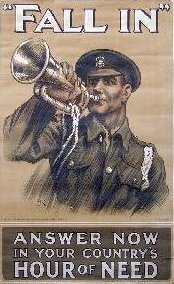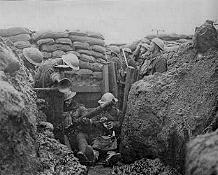

The Great War 1914 - 18
In 1921, to make some sense for historical description of these continual and complex battles, the various actions involving the British army were defined and named by the Battles Nomenclature Committee. It is their definitions that are used on this page. The early battles were very small in scale compared to the immense affairs of later in the war. Nonetheless, for the army that was present at the time these actions were of great importance, and they are all listed accordingly.

1914
The Battle of Mons and subsidiary actions 23 - 24 August 1914
The Battle of Le Cateau and subsidiary actions
26 August - 1 September 1914
The Battle of the Marne 1914 7 - 10 September 1914
The Battle of the Aisne 1914 and subsidiary actions 12 - 15 September 1914
The Defence of Antwerp 4 - 10 October 1914
The Battle of La Bassee 10 October - 2 November 1914
The Battle of Messines 1914 12 October - 2 November 1914
The Battle of Armentieres 13 October - 2 November 1914
The Battles of Ypres 1914 ("First Ypres") 19 October - 22 November 1914
Under the command of Sir John French up to October 1915, the BEF lost the core of the pre-war regular army while being greatly outmanned and outgunned. It became clear that the enemy positions could be broken into, but not broken through, without the deployment of much larger forces. Under Sir Douglas Haig, most of the New Armies fought their first major engagement on the Somme.
This phase of the war was a time of great and rapid technological and tactical development: poison gas, flame-throwers, and grenades (in 1915, tanks and ground support from aircraft (in 1916), predicted artillery and machine gun barrages (developed from mid-1916). Equally, sophisticated defence was developed, including extensive use of underground works, concrete shelters and emplacements, counter-battery artillery fire, and mining (which was also used offensively)

Winter Operations 1914-1915
23 November 1914 - 6 February 1915
1915
The Battle of Neuve Chapelle and subsidiary actions
10 March - 22 April 1915
The Battles of Ypres 1915 (Second Ypres)
22 April - 25 May 1915
The Battle of Aubers 9 - 10 May 1915
The Battle of Festubert 15 - 25 May 1915
Other actions in Spring 1915 15 June - 9 August 1915
The Battle of Loos and associated actions
25 September - 18 October 1915
1916
Actions in Spring 1916 14 February - 13 June 1916
The Battles of the Somme 1916 1 July - 18 November 1916
1917
Operations on the Ancre 11 January - 13 March 1917

A section of the formidable defensive positions faced by the British army when it attacked at Ypres on 31 July 1917

1917
German Retreat to the Hindenburg Line 14 March - 5 April 1917
The Arras Offensive and associated actions 9 April - 16 June 1917
The Battle of Messines 1917 and associated actions 7 June - 11 July 1917
Operation Hush, 1917 Cancelled
The Battles of Ypres 1917 (Third Ypres, or Passchendaele) 31 July - 10 November 1917
The Cambrai Operations and associated actions 20 November - 30 December 1917
It was revolution in Russia that changed the nature of the deadlock in the west. Fighting in the east stopped in late 1917, allowing the Germans to transfer many Divisions to the Western Front. They knew that time was running out, for the United States of America had now entered the war on the Allied side and it was only a matter of time before vast untapped reserves of manpower swung the balance in favour of the Allies.
The Germans struck in the Kaiserschlacht offensive on 21 March 1918. Such was the vigour of their attack that they broke through the British line and pushed towards the key positions of Amiens and the Channel Ports. Held only after the bitterest of defensive fighting, the Germans effort was exhausted and the line froze once more. The Allies gained strength, barely understanding that the Germans had "shot their bolt". From the launch of a surprise attack at Amiens in August 1918, until the Germans called for an Armistice in November 1918, Haig's British armies, by now battle-hardened and having learned the hardest way of all, equipped and supplied to the highest standard, pummelled the foe in a great and almost continuous advance.

1918
The First Battles of the Somme 1918 and associated actions
21 March - 4 July 1918
The Battles of the Lys 9 April - 29 April 1918
The Battle of the Aisne 1918 27 May - 6 June 1918
The Battles of the Marne 1918 20 July - 2 August 1918
The Battle of Amiens and associated actions 8 August - 17 August 1918
The Second Battles of the Somme 1918 21 August - 3 September 1918
The Advance in Flanders 18 August - 6 September 1918
The Second Battles of Arras 1918 26 August - 3 September 1918
The Battles of the Hindenburg Line and associated actions
12 September - 12 October 1918
The Final Advance in Flanders 28 September - 11 November 1918
The Final Advance in Artois 2 October - 11 November 1918
The Final Advance in Picardy 17 October - 11 November 1918
